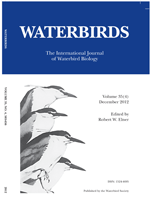The study aim was to describe and explain the distribution of waterbird breeding colonies in the vicinity of one of Uganda's largest rice schemes, Doho, a major feeding site for waterbirds. A total of 18 colonies were identified in which six species bred and two others were found roosting. Colony size ranged from seven to 588 breeding pairs. All colonies were located within human settlements, contrasting with patterns seen in typical waterbird colonies in Europe and America. Seventy-five percent of waterbirds placed their nests on Mvule trees (Milicia excelsea) while the number of breeding pairs was positively correlated to the number of trees at colonies. Contrary to expectations, colony size was not correlated with distance from the Doho rice scheme, or with the amount of foraging area within one, five and 10 km from the colony. These results suggest that nesting, rather than foraging habitat could be restricting the distribution and potentially population sizes of tree-nesting waterbirds in our study area. They also highlight the importance of the Mvule as nesting habitat for waterbirds, a tree species that is in great need of protection throughout Uganda, and presumably throughout other parts of Africa.
How to translate text using browser tools
1 December 2012
The Distribution of Colonial Waterbirds in Relation to a Ugandan Rice Scheme
Sarah Nachuha,
John L. Quinn
ACCESS THE FULL ARTICLE

Waterbirds
Vol. 35 • No. 4
December 2012
Vol. 35 • No. 4
December 2012
agriculture
colonial birds
Doho
rice scheme
Uganda
wetland




